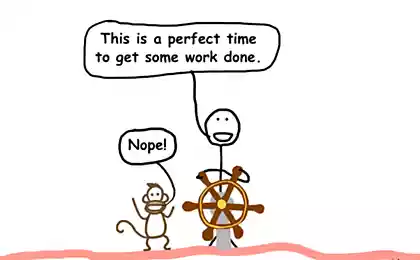235
How to defeat laziness: a scientific approach to overcoming procrastination

Laziness is not a character defect, but a complex psychophysiological mechanism that can be studied and reprogrammed. Modern neuroscience offers specific tools to transform this state into a powerful source of motivation.
Each of us is familiar with this feeling: an important task awaits completion, a deadline is approaching, and we continue to postpone actions until later. Laziness seems to be an irresistible force, but in fact it is the result of evolutionary mechanisms that once helped our ancestors survive, and today prevent them from achieving their goals.
Research from the University of California has shown that procrastination activates the same areas of the brain as physical pain. That is why avoiding complex tasks brings instant relief.
The Neurobiology of Laziness: What Happens in the Brain
Modern studies using functional MRI reveal amazing facts about the nature of laziness. When we are faced with a difficult task, it is activated. frontal cortex The area of the brain responsible for conflict processing and decision making. At the same time, the limbic system is switched on, which signals danger and stress.
The dopamine neurons that form the reward system begin to “bargain”: the immediate pleasure of simple actions seems more attractive than the delayed reward of doing difficult work. This mechanism is evolutionarily justified - our ancestors had to save energy for critical situations.

Prefrontal cortex versus limbic system
The key to understanding laziness lies in the opposition of two brain systems. Prefrontal cortex It is responsible for planning, self-control and long-term thinking. limbic system It focuses on immediate needs and emotional responses. When the limbic system wins, we take the easy path.
Use the “5 Minute Rule” to follow. Start the task for 5 minutes without thinking about the outcome. This activates the prefrontal cortex and reduces the resistance of the limbic system.
Overcoming strategies: from theory to practice
1. Decomposition technique
Complex tasks are perceived by the brain as a threat. Break them down into microtasks that can be done in 15-20 minutes. Each completion of the microtask activates the reward system and creates positive feedback.
Success story: Writer Anthony Trollope created 47 novels, working just 3 hours each morning before the main job. He wrote exactly 250 words every 15 minutes, turning the creative process into a system of small achievements.
2. Pomodoro 2.0 Method
The classic Pomodoro technique offers 25 minutes of work with 5-minute breaks. Modern adaptation takes into account individual biorhythms. Find your optimal concentration interval through the experiment: start with 15 minutes and gradually increase to a comfortable maximum.
A University of Illinois study found that short breaks during long tasks significantly improved the ability to maintain concentration and performance.
3. The principle of anchoring habits
Link the new behavior to an existing habit. For example: “After I have my morning coffee (anchor), I will immediately open the working paper (new behavior).” The brain perceives such connections as natural, reducing resistance.

Psychological hacks against procrastination
Reformatting the internal dialogue
Replace “I must” with “I choose.” Studies show that the sensation of choice activates motivation centers in the brain, and coercion causes resistance. Instead of “I need to write a report,” say “I choose to write a report to do so.” . . ?
The Future Me technique
Visualize yourself an hour, a day or a week after completing the task. Neuroimaging shows that this practice activates the same areas of the brain as the actual experience of success. The feeling of satisfaction from completed work becomes a motivating factor.
Experiment: Before starting a complex task, take 2 minutes to visualize your sense of completeness. Imagine the emotions, the physical sensations, the pride of the work done.
Social accountability
Publicly announce your intentions. The mechanism of social approval is older than logic—no one wants to look incapable of keeping promises. Find an “accountability partner” or use social media to create commitments.
Energy Management: Fuel for Motivation
Laziness often masks resource depletion. The brain consumes 20% of all the energy of the body, and with a lack of “fuel” it goes into saving mode. Optimizing your physical condition is critical to overcoming procrastination.
Chronobiology of Productivity
Each person has individual peaks and energy drops throughout the day. Most people experience maximum concentration 2-4 hours after waking up. Plan your most challenging tasks for periods of natural energy peaks.
Studies of circadian rhythms show that cognitive performance can vary by up to 700% depending on the time of day and whether tasks match biological rhythms.
Brain nutrition
Stable blood glucose levels are critical to maintaining willpower. Avoid sudden spikes in sugar from fast carbs. Optimal diet: complex carbohydrates, omega-3 fatty acids, antioxidants. Even mild dehydration reduces cognitive function by 12%.
Technology assistants
Modern digital tools can become powerful allies in the fight against laziness, if used consciously. Distraction blocking apps, time trackers, interval programs are all external structures that maintain internal discipline.
Gamification of process
Turn work into a game. Create a system of points, levels, achievements. The brain responds to game mechanics by releasing dopamine, which makes the process naturally motivating. Keep an account of completed tasks, mark personal records, arrange competitions with yourself.
Remember: the goal is not to never be lazy, but to consciously choose moments to relax and moments to be active. Laziness can be a signal of the need for recovery, not always a problem to be addressed.
Long-term transformation
Overcoming laziness is not a one-time victory, but a gradual change in neural patterns. Every time you act against the will to put things off, you strengthen the neural connections responsible for self-control. It’s like muscle training – the results accumulate gradually but become sustainable.
The key principle is to start with micro-change. Instead of drastically rebuilding your life, choose one little habit and work with it 21-66 days before automatism. Then add the next one. This approach corresponds to the brain’s natural adaptation mechanisms.
Keep a “winning diary” – write down even the smallest achievements. The brain remembers positive experiences better when we record them, which creates a sustained motivation for future actions.
Laziness ceases to be an enemy when we understand its mechanisms and use science-based strategies to overcome it. Everyone is able to reprogram their reactions and create consistent patterns of productive behavior. Start with one small step today – your brain is ready to change.
Glossary
Procrastination The tendency to delay tasks despite understanding the negative consequences of such behavior.
Prefrontal cortex The area of the brain responsible for executive functions: planning, decision-making, self-control and working memory.
limbic system The complex of brain structures involved in the formation of emotions, motivation, memory and behavioral reactions.
dopamine A neurotransmitter that plays a key role in the brain’s reward system and the formation of motivation to act.
Circadian rhythms An internal biological clock that regulates physiological processes in accordance with a 24-hour cycle.
Neuroplasticity The ability of the brain to change its structure and function in response to experience and learning.
Gamification Applying game elements and mechanics in non-game contexts to increase motivation and engagement.
What to do if a loved one does not meet your expectations
10 Signs You and Your Girlfriend Have Been Roommates























